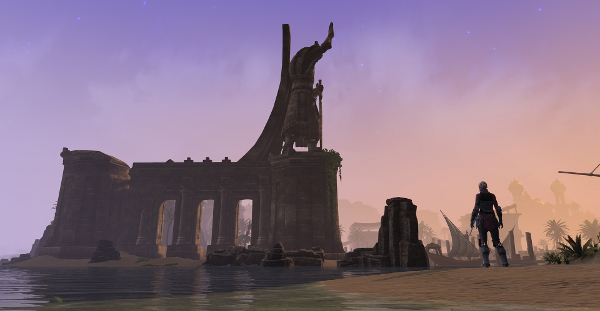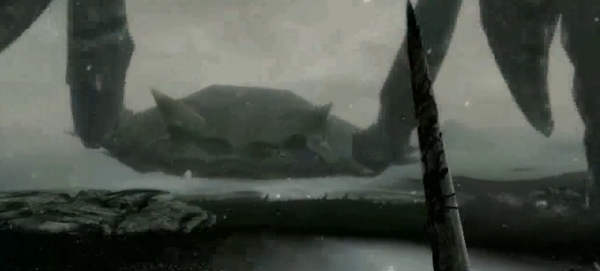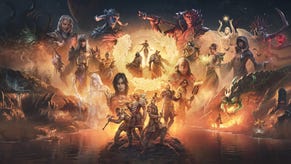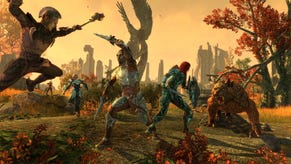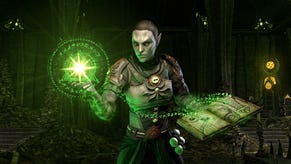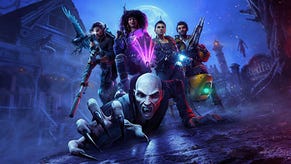Zenimax On TESO's First-Person Mode, Mudcrab Armies
The Mudcrab Interview
I recently ventured to Zenimax Online's mighty fortress in the fantastical kingdom of Baltimore, and I was very good. I only spent 40 percent of the time incessantly quoting The Wire. When not explaining to random passers-by why you best not miss when you come at the king, I even played some videogames! Specifically, The Elder Scrolls Online, because Zenimax kinda makes that and stuff. I did, however, come away with quite a sizable list of concerns, as this one's DNA struck me as decidedly more MMO than TES. But a promising-looking first-person mode suggests Zenimax is paying attention to the wishes of the fantasy titan's truly colossal fanbase, so I decided to air my grievances directly. Click past the break for lead gameplay designer Nick Konkle's responses to Zenimax's almost comically abrupt turnaround on first-person, TESO's ability (or lack thereof) to replicate the moments of AI-driven randomness TES players so love, PvP's potential for maniacal politicking, the open class system, and - of course, most importantly - mudcrabs. Mudcrabs, mudcrabs, and more mudcrabs.
RPS: Just a few weeks ago, you said that first-person and TESO's combat simply wouldn't mesh well. 360 degree attack radii and all that. Why'd you change your mind? Will the implementation of first-person require a combat revamp?
Nick Konkle: Well, I think there’s any number of reasons. I definitely do not feel like it’s at odds with the style of combat that we’ve built. Our third-person game wasn’t necessarily developed for very, very zoomed-out from above. When we built the combat system, we targeted having your camera be close up on the character, character off to the side, but in the world. Immersion was always a key part of it. Yes, first-person is certainly a different perspective than third-person over-the-shoulder, but we’re talking half a meter forward and half a meter left. That changes the perspective somewhat, but not nearly as much as if you were 20 meters zoomed out looking down on your character. That wasn’t our intent in the full game.
The transition isn’t as bumpy as you might think, as far as any changes to our core game systems. It’s been much more focused on ensuring that the things that did change – and you bring up a pretty good one as far as situational awareness goes – are communicated effectively in first-person. That’s where you get into things like hit indicators and enemy indicators when they’re in different directions. That is a really good, classic example of the problem that happens when you go from third to first. But there are others. Each one we’ve handled individually. But the core system, because it was built for being in the world and immersed, didn’t have to change.
RPS: When did you start developing this system? It already looks pretty far along. And if it is, why'd Zenimax pretend like it didn't exist a few weeks ago?
Nick Konkle: There’s a couple of different answers. As far as how long we’ve been planning on it and wanting to do it, it’s really since the beginning. There’s definitely a class of people who we feel like, for sure, they want to play the game, they want to play an Elder Scrolls game in first-person. I absolutely agree. That is what a lot of people feel like, and are right to feel like, is an essential Elder Scrolls experience.
But the first thing we wanted to do was focus on our core game. For the core game and the core perspective, we picked that third-person over-the-shoulder – zoomed in on the world, but with your character on the screen nonetheless. It was when we felt like we had that locked down [that we began honing first-person]. Okay, we know our core game. It’s working. It’s playing the way we want it to. We have all the mechanics built up. That was the moment where it felt like, okay, now it’s time to start building the first-person and start getting that in the game.
That makes it sound like it was entirely planned the whole time, which isn’t true. We announced the game a while back. It was something a lot of people felt really passionate about. We read the forums. I read the things that say HEY DEVS READ THIS on forums. That’s what we do. It was clear that it was something that was a point of passion for a lot of people. I think that really helped us move the needle – like, this is going to be hard, this is a challenging production problem, but we just have to do it. That was why we did it. I think that happened fairly recently.
RPS: When I was playing in third-person today, there were lots of vision cones for enemy attacks, and high-speed, distance-covering dodge-rolls were crucial. How will that translate into first-person?
Nick Konkle: Those attacks and those core gameplay elements are still in there. We find that the telegraphs themselves still work perfectly well. In fact, you have a nice perspective on the ground that isn’t impeded in any way by your own character. That’s kind of nice. In some places it actually feels better. Motion and moving about in combat is always something that we want our core game to be about. It’s something that’s in Skyrim. It’s something that’s interesting in RPGs. We don’t want just a standard MMO where people are static and exchanging blows until one person dies. Yes, that’s a key part of the system, and in first-person, it is realized in its own way.
RPS: Ultimately, though, I still felt like I was playing an MMO first and an Elder Scrolls game second. Why did you go in a direction that so heavily favors more rigid zones, quests, and things of the like?
Nick Konkle: Certainly meshing those two has always been our main design philosophy, what we strive very hard to do. I think maybe the missing element was first-person, experiencing it in that way. It depends. It’s different for different people. The Elder Scrolls games are so broad. Different people get different things out of them. For some people, what really sells it is the progression. For others it’s the way in which you interact with the world. For others it’s first-person mode. Really, what we’ve been trying to do is, one by one, put those things in our game in such a way that they do make it a cohesive experience. Maybe right now it doesn’t feel that way to you, but maybe it will in the future. We’ll definitely keep pushing that.
RPS: I think another thing was the overall sense of possibility Bethesda's Radiant-AI-powered worlds can create. A lot of the series' personality actually - at least, for me - doesn't come from the lore. It's all the weird stories AI interactions or even glitches spawn. Or my ability to mess with the world. To steal everything or roll a million cheese wheels down a mountain or whatever.
Nick Konkle: Well, I think there’s a number of things TESO can do that are similar to that, and some that it possibly cannot. Those tend to have to do with making the experience unplayable for someone else. A big example is, why can’t I just go kill this quest giver in the town? Everyone knows you can do that in Skyrim, although a lot of times he’ll just go unconscious and come back up. But everyone knows you can do that in Skyrim because you can reload. You can’t do that in an MMO.
As far as dynamic interactions, there’s a number of places we use that, but I can tell you that in our combat system, that was something we focused heavily on. Let’s not build anything that requires exactly these three guys to play together, and they’d better only appear as a group. Every NPC, every enemy in the world, should be looking at the area around them, seeing who else is available, seeing what the environment is, and trying to take advantage of it. What’s really cool about that is, when you spawn in one scenario, you know what it’s going to do. It’s fixed. But here – oh, crap, something else happened. Another player affected the terrain. I did something unexpected. All of a sudden, you have this battle that was completely unexpected.
RPS: Right. Which is in your combat scenarios. But with other Elder Scrolls games, it’s in all the other incidental things as well Characters going about their daily lives, and occasionally that’ll make something completely weird happen where the resulting scrap doesn't even involve you. TESO's NPCs felt more like standard, largely static quest-givers.
Nick Konkle: We have a couple of different types of NPCs, and a couple of different Radiant events that fill that role. For example, we have what we call critters in the game, monsters that aren’t going to fight you. They’re actually aware of whether there’s predators in the environment. They will flee them and son and so forth. Sometimes that goes all the way up to deer. What you might find is that if you run out in Glenumbria and come upon a deer, they’ll scatter, but then they’ll see a wolf, and so they’ll run from that, and the wolf will run them down and kill them. There is a certain amount of that, especially with the critters, creating that living predator-prey relationship.
With our NPCs, there are certain ones, typically the quest givers, that are intended to stay within a specific area and help create a flow for people who want to follow the story in a very specific way. But then there’s what we call… I don’t know if we use the term “radiant NPCs,” but we might say “filler NPCs.” They wander the towns, and they themselves have a story, but it’s not related to a quest. They’ll just go around and then they’ll interact and sometimes they’ll talk with quest givers. There are different numbers of those. If you go in an area like Daggerfall and run around, you might start to see more of those NPCs who are just living there, but aren’t affiliated with a quest, interacting with each other and talking and doing various things.
RPS: I wanted to clarify something I heard during the presentation today: there was a stat cited that was something like, for each alliance’s different portion of questing, it would be about 120 to 150 hours of content?
Nick Konkle: I believe that was the target at one time. Around 140.
RPS: But is that factoring in if you do all the main quests and all the side quests in that area? Or is that if you just mainline it and go straight through, doing if not the bare minimum, then all the main quests and a couple of side quests when you see fit?
Nick Konkle: The answer to that is actually a bit of a tricky one. You can play the game very, very directly. If you really are just trying to get to the end as fast as possible, skipping all the story elements, really moving as quickly as possible, it’s a very different speed than if you actually, say, listen to the story or watch any of the theater that unfolds. You don’t have to. You can just go skip-skip-skip.
What the target – that number, the 120-140… We treat it as what an average player might do. Sometimes they’re going to listen to the story, get heavily invested, care about the characters. Sometimes they’re going to completely explore. Other times they’re going to say, nah, I’m not super interested in this area. I’ll just move over to the next one. They’ll speed through it or skip it entirely. It comes more from, we have a lot of different people playing an area. So it’s kind of an average. I would describe that as an average target, if that makes sense.
RPS: What about on the PvP side? How does the alliance system function there? What sort of benefits do factions that hold multiple keeps in Cyrodil win?
Nick Konkle: I don’t think we’re specifically talking about what they are, but they’re global things that pertain to every character in the game that everyone wants, and not something that’s like, oh, this just gives you more PvP points. It’s an alliance-wide benefit. When your side has it, you’re happy.
RPS: Could you see the results of that system being fairly political? Or is it more going to be like, we fight, we get a benefit, then we lose it and we try to take it back?
Nick Konkle: Oh, no. It’s absolutely intended to be political. That’s part of the reason for having three sides. It’s because it isn’t just, well, who is winning right now? If one side starts to win, then the other sides are like, let's team up, and then they rush that guy [laughs]. You can absolutely have politics based around that.
There will be periods where everyone can feel like, let’s just go ahead and keep things the way they are right now, because if someone rushes I might get taken out. You might have extended periods like that. This is the way the PvP system in other games work, that we’ve used as our reference and targets. It kind of plays out in that way. It’s something we wanted to bring over to this game.
RPS: I remember, about a year ago, there was talk of an Emperor system related to that. A single player could become Emperor via PvP deeds. Is that still in?
Nick Konkle: Yeah. We’re not discussing details of it, but it is the case that someone can, from a single alliance, if they get to ascendancy… They can attempt to make themselves the Emperor. It would be incredibly difficult to maintain for any significant period of time. They would probably get ganged up by the other alliances. But it is something that is possible and is a part of the game. Specific details will be coming down the line.
RPS: What are the story ramifications of that? I mean, will those players be immortalized in the series' lore and stuff?
Nick Konkle: It’s funny. In the lore of the time, this is a period of great conflict. What happened was, many pretenders to the throne rose. Out of all of those pretenders came Tiber Septim. He was the one who made it work. He could light the dragonfires. He began the Third Era. We’re in the Second Era, before that happened. So maybe it’ll be possible that one of the players is a pretender, or maybe it’ll be possible that you can work your way up there, and then you’re actually Tiber Septim. That’s the sort of thing that’s going to keep the players intrigued.
RPS: You have an almost entirely open class system that allows anyone to equip nearly any skill set. At that point, what’s the point of a class system at all? Why not just give players the option to begin as blank slates?
Nick Konkle: There’s a few things. The main thing that I really like about it, about what happens in our playtests, is that it gives you a nice little bit of differentiation. It’s very social. It’s three skill lines out of 20-plus that you’re going to end up with. We’re starting with 12, but it keeps growing. You’ll only ever have the three that come from your classes. The way that those start you off, and then ultimately interplay with all the other skills that you and everyone else can get, does make a nice social experience.
One of my favorite experiences in our post-game playtests is when, at the end of the big PvP battle or a dungeon run, everyone sits down and starts post-gaming their builds. Here’s what I did. Here’s what I tried. I did this class and this armor type. Here’s how I used my magic, because I wanted to accomplish this one thing. Mostly I focused on stamina. Something along those lines. I have very rarely heard people feeling like, this is the dominant thing. They say, I’m sure my thing is the best, and then someone finds something that beats it. Then it keeps moving around. It’s both social and it gets people a starting point as far as what makes them unique and trying different builds. It’s also just kind of a cool thing, to be able to say, this is something I can do that’s unique. That’s something we like.
RPS: You mentioned that after the game launches, you’re going to investigate a Thieves guild. I was wondering how that would work. Would you have quests that emphasized the sneaking system and things like that? Do you already have some like that?
Nick Konkle: I will say that I don’t necessarily want to speculate on a system that we’re ultimately going to release post-launch and lock down the details later. But a lot of the ways in which we have built the sneaking system up to this point, with the detection, with the awarenesses there - and similarly with being able to pick up objects in the world – was built with a back end in mind for, hey, we’re going to expand on these in a certain way to allow for this stealth being something that’s a game of its own. That’s something we’re pretty excited to work on and get in there. We do know that people love sneaking and thieving. We do too.
RPS: This is, of course, the most important question. Mudcrabs. How many kinds you gonna have?
Nick Konkle: [laughs] Let’s see if I can count. There’s a number of different species. I associate them with the color. I’m trying to remember… It’s greater than three. Maybe like five, when I imagine them in a line? There’s five different types of mudcrabs. That’s a species. There are larger ones that potentially do stronger things as well. There’s some variances there.
RPS: Do they have more attacks than just the burrowing?
Nick Konkle: That’s only what the base, simple mudcrab does. Yes, they absolutely do more things. Higher-level mudcrabs, you don’t want to mess with those things.
RPS: Do you remember the mudcrab from Morrowind that sold stuff?
Nick Konkle: Yeah, the vendor? Sure.
RPS: Will there be any appearance from him in the game? He strikes me as an ageless being. It seems possible.
Nick Konkle: It certainly seems like he would have stayed around. That’s the sort of thing that we as developers love to potentially include in the game as different parts. But it’s very much the sort of thing I like players to discover when they go and play the game, like how you become a vampire. We could tell you, but let’s just let you go find out. You can go play the game and find things like that that are fun.
RPS: I heard tell of a mudcrab army.
Nick Konkle: [laughs] Certainly there are scenarios where large numbers of mudcrabs will be summoned. We may or may not refer to that as the mudcrab army.
RPS: What about a mudcrab dungeon? Could you ever do that?
Nick Konkle: We have mudcrab bosses. I’m gonna be honest. And mudcrab-based encounters. But there isn’t anything that is exclusively mudcrabs. We care for that creature. It is truly a great creature in Elder Scrolls lore.
RPS: What about mudcrab mounts?
Nick Konkle: [laughter] The mechanics of that seem really challenging. You could go underground with them…
RPS: Well, I mean, it'd be giant.
Nick Konkle: Yeah, sure. I’m picturing goodness too. I can tell you that we’re not releasing details of the mount system, other than that we’re going to have mounts in our game and they’re more than just cosmetic. They have a role and they do have unique properties.
RPS: Also, cliff racers. Are they in?
Nick Konkle: Yes. There has never been a more divisive monster than the cliff racer. The jump attack. Ugh. Man.
RPS: Are they just going to be following me around someplace? Constantly? Incessantly? Until I break?
Nick Konkle: Yeah, every time they attack, three more spawn [laughs]. Uh, cliff racers are… Well, I’ll tell you what. That’s another one I want to let people discover. We have fun.
RPS: Okay. I’m going to assume the main bad guy is a cliff racer that never stops following you.
Nick Konkle: Yeah, absolutely. Shadow over the ground…
RPS: Thank you for your time.






